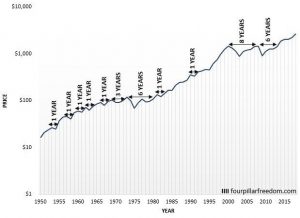APPENDIX
LOCKEBRIDGE ARTICLES PUBLISHED PRE-2008 CRASH
- “For What its Worth”,
Walls & Ceilings Magazine, May 2006,
https://www.wconline.com/articles/84852-for-what-it-s-worth
Article Synopsys
In this article LockeBridge is warning all business owners whose businesses are sensitive to the health of the housing market to seriously consider selling their business if they do not have an appetitive to ride out a potential down cycle in the industry, which can easily last for five years.
Article Extract
“Timing is everything. A significant decline in the National Association of Home Builders’ Housing Market Index over the last five months indicates a continued slowing in the housing market. There does seem to be a relatively high level of uncertainty in the industry, so if your time horizon is relatively short, less than five years, you may want to consider selling in the near future while merger and acquisition activity is still relatively strong and there is an abundance of money searching for good companies.”
- “Should I Sell or Should I Grow. How Will the Slowing Housing Market
Effect the Value of Your Company?”, Walls & Ceiling Magazine, June 2006.
Article Synopsys
This article explains how macro-economic trends occurring in 2006 can dramatically negatively impact the enterprise value. Additionally, the article discusses common value deflators and how to minimize their impact on the business value.
Article Extract
“As I write this article on the 31st day of March, the Chairman of the Federal Reserve Board, Mr. Bernanke, presides over his first meeting of the Federal Open Market Committee, the group that sets interest rates. Today they announced that they are continuing the gradual interest rate-raising campaign. It was the 15th such increase since the Fed started tightening credit in June 2004. The prudent building supply company owner has to ask himself “at what point will rates hurt my business?
The prime rate is at its highest since the spring of 2001. The National Association of Home Builders Market Index, a measure of builder sentiment, fell to 55 yesterday (see graph), the lowest figure since April 2003. At the same time, mortgage applications as measured by the Mortgage Bankers Association have fallen five out of the past seven weeks. These figures indicate a market slowdown. What does this mean to the value of your company?”
- “Metal Industry Owners Face a Difficult Decision, Should I Sell or Should I Grow?”,
Recycling Today Magazine, June 2006
Article Synopsys
This article explains how industry specific variables, relevant to the metal industry, such metal commodity prices, overseas shipments, etc., lead one to believe that valuations may have peaked and industry risk is high. The article also provides pointers on how to mitigate such risk and ways to optimize valuation.
Article Extract
“As previously stated, the metals industry is at an all-time high. Where we go from here is anyone’s guess. There does seem to be a relatively high level of uncertainty in the industry, so if your time horizon is relatively short, less than five years, you may want to consider selling in the near future while the industry dynamics are extremely positive and merger and acquisition activity is strong with an abundance of money searching for good companies.”
- “For Sale? How have unprecedented metals prices affected the value of your company?”
Recycling Today, August 2006, https://www.recyclingtoday.com/article/for-sale-/
Article Synopsys
This article emphasized that there is a high level of uncertainty in both the macro-economy and within the metal industry. It urges Business Owners that are not prepared to own their company in a potentially highly volatile business environment to seriously consider selling. The article further discusses how best to prepare for a sale of their company.
Article Extract
The objective of this article is to ensure that readers understand that several considerations will affect their businesses’ values and to encourage prospective sellers to put as much effort into the selling process as they have into their companies’ operations. After all, the average selling process lasts about one year, but when executed correctly, it can yield as much as the total cumulative earnings that the owner has made over the life of his or her company.
- “Metal Industry Valuations”
Recycling Today Magazine, October 2007
Article Synopsys
The author, Scott Waxler, is extremely sensitive to the historically high run up in metal prices and the implication on enterprise value for companies participating in the metal industry. The article discusses valuation methods and how to account for metal price variability.
Article Extract
The unprecedented run up in base metal prices has necessitated the creation of alternate valuation techniques. Dynamically changing metal prices have resulted in a widening of valuation ranges for companies dealing with these commodities. Profit increases resulting from the increases in the underlying commodity price are not viewed as sustainable or controllable and therefore must be normalized.


